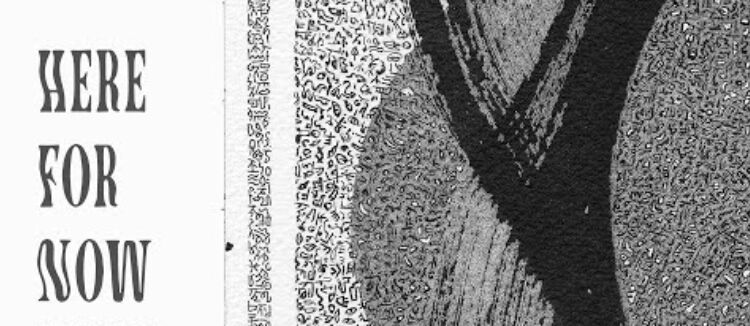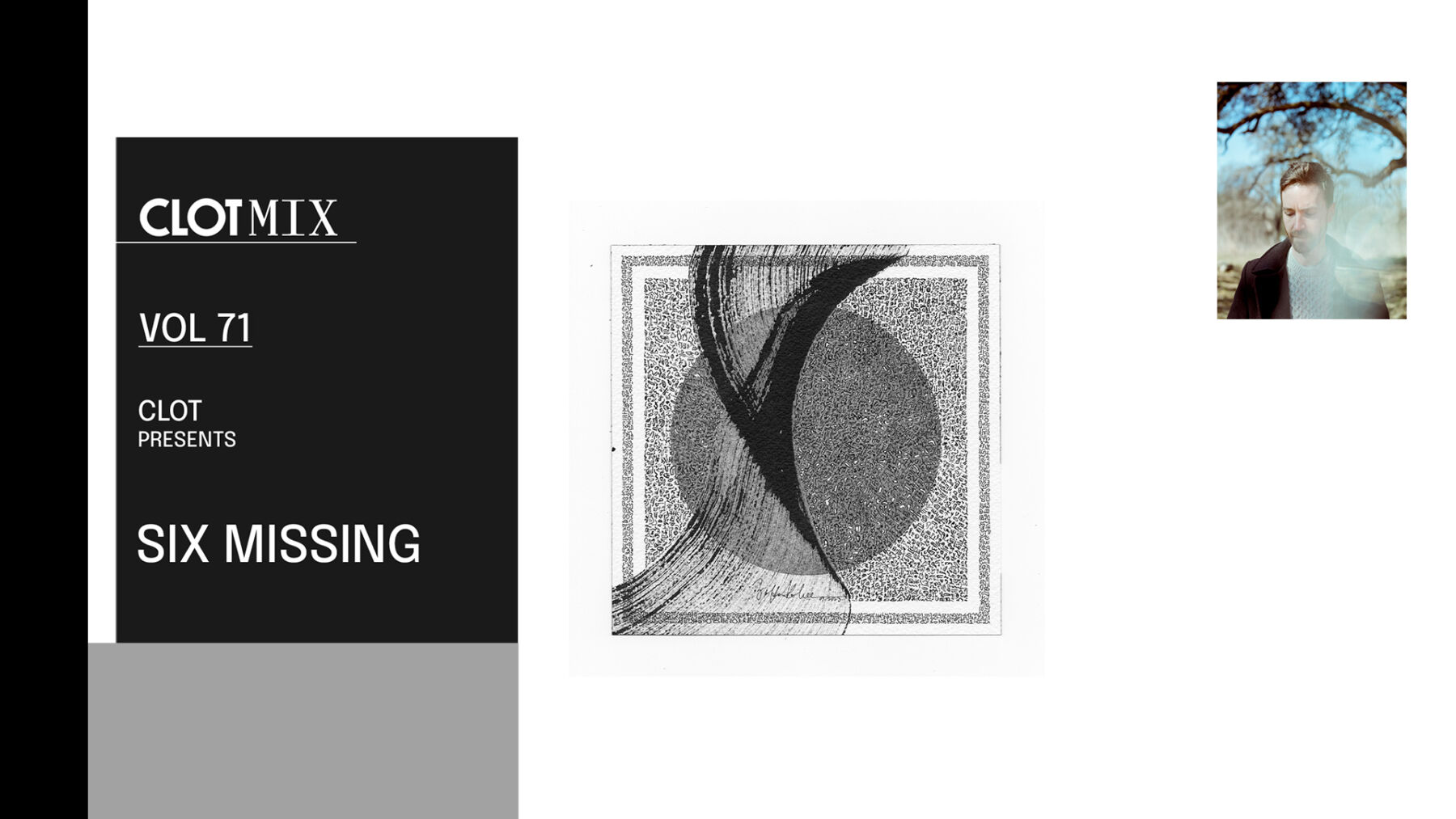Text by CLOT Magazine

We kick off the year with a mixtape from Six Missing, the ambient music project from Austin-based TJ Dumser, with which he wants to take us on a journey with pieces that transcend the illusion of time – transporting you into a timeless, formless, galactic-jell-o.
The artist, who is also a sound designer and composer, began releasing music under the name Six Missing in 2017, a moniker that he took after experiencing a supernatural experience while recording in a studio near the site of the Revolutionary War’s Battle of Brandywine, in Pennsylvania, in which six participants remain unaccounted for.
For Dumser, Six Missing is a way of experiencing music that is meant for inner journeying, calming sensations, and finding peace. The project started by experimenting with ambient and modular systems, and several albums down the line, Six Missing released his latest album in December last year. Titled Here For Now, the album deals with themes around being in the present moment. For Dumser, this was during a time of displacement for him and his wife as a way to cope with the uncertainty. Here For Now is comprised of what Dumser refers to as “musical compost” — a concept that isn’t nearly as derogatorily gesturing towards the material as it sounds: It’s a bunch of work that I’d previously done that I’d set out to release in its form, but something didn’t feel totally right.
For the mixtape he has prepared for us, Dumser says that he wanted to find tracks that were on the longer side, with a quiet confidence in their sparseness or even the guts to make production decisions that he admires. For him, Music algorithms these days are giving preference to shorter, more consumable, bite-sized pieces of music, and it makes complete sense to me. However, as a listener, I want to really spend some *time* with an artist and allow myself to sink into their work.
He also mentions that he came into the world of ambient when he was living in upstate NY and commuted to the city two hours each way every day for his job: I would pop on tracks that would be slow and evolve over time, becoming the underscore for the world and landscape whipping by my window of the Metro-North Hudson Line. I loved how the soundtracks and sonic journey would sculpt my experience. It added drama to an otherwise mundane experience. Whenever he writes music, he continues, he’s subconsciously attempting to re-create the magic of those moments spent on the train.
I love a piece of music that stands confident in its repetition and sparseness and allows you to drift and float away in the world the artist has so lovingly created for you. Spacious Mind means an uncluttered mind. A calm mind. A mind free of distractions where your subconscious can run about freely just for fun.
In your new album, Here For Now (Netwerk Music, 2023), the notion of presence acts as a thematic anchor. What was your creative process like for the album production? Was it different from your previous compositions?
The process for this album was, in fact, quite different from previous works in that I had created and put together an entire album’s worth of material, had it ready to go, and then decided that the pieces felt “unfinished” and pulled it down and stuck it on the proverbial shelf for a while.
The files just sat there as I attempted to work on other material, but something about them kept calling to me – so I sat and listened to them again and realised that I was staring at beds; instead, I had all this kindling to start with. I had never really looked at pieces like that before – and what I think makes this unique is that there is a depth to the tracks now that some of my other works don’t have. Because the starting point was, in fact, the “ending” point, it had this added layer of intensity to it – and from those starting points, I began writing and building.
It’s almost like when you make a soup – you layer in the flavours by starting with the onions and the garlic, letting them meld together before adding broth. It was a super freeing feeling to work with source material that was so sonically complex – it allowed the additional writing to be less busy and to have all this air and breathing room. I loved doing it this way, and I want to try it again on future projects – allowing the initial phases to be more experimental and freeform, knowing that they will only make up one element of what the final piece will become.
Your music is meant for inner journeying, calming sensations, and finding peace. What were you exploring on the more technical side? Any new equipment that you tried for these productions?
That’s a great question! I mainly want to eliminate as many hurdles as possible while working in the studio. So, from a technical standpoint, I always try to have everything plugged in and ready to go. Everything is wired up in the studio, and I can send and receive audio to and from anything.
Everything talks to itself in my workflow, meaning I can be as wild and experimental as I like. I could say, “I wonder what it would sound like to send the Juno to the Hologram Chroma Console BUT THEN send that into Make Noise QPAS in my modular rack,” and I can do it all with a few mouse clicks. It lends itself to some really fun combinations, which essentially become a sound I could’ve never imagined when I first started. All that is to say, I want to stay in that flow state, that “moment,” while working. If I drop in and find myself completely absorbed by a sound I’m working with, the last thing I want to do is think about if it’s routed correctly. So, the technical side of things frees up the creative side.
Regarding new equipment, I’m a bit of a collector of music gear, so yes, there were quite a few new toys employed on this record – namely, the Korg PS-3100, which is my new love. This truly polyphonic synth from the late 70s is whacky and weird with its sound, but that’s what I love about it. And that’s what I love about synths – they are temperamental, just like humans!
What are your main inspirations for your artistic practice these days?
I draw a lot of inspiration from nature and my environment – I like to go for walks and listen to all the different sounds around me; it’s a symphony of the most beautiful kind. There’s randomness, but there’s also order, and I find that truly fascinating. Meditation is another big part of my life – I’ve been practising for about five years. I think there’s a misconception about meditation that people have where they think the objective is to stop your thoughts – that really couldn’t be further from the truth.
The goal of meditation is not to have a goal. You’re identifying thoughts and seeing them as though you were standing at the river’s edge rather than jumping into the river. You can’t stop the river. You can, however, choose to watch it and realise you don’t have to do anything about it.
Outside of those two things, I also try to keep a pretty regular schedule for working and writing – mainly because I am still on that 9-6 work schedule. Of course, I am flexible whenever inspiration comes, but for the most part, I find that by telling myself that I have this set window every day to go in and work, I can be more successful in completing things.
What have you been most excited about recently about the Texas/Austin experimental scene?
I don’t get out of the studio and my neighbourhood all that much, so I will have to get back to you on that!
What is your relationship with technology and the analog for your productions nowadays? And how do you cope with technology (screen/digital) overload?
This is a significant topic that I could discuss at length. To oversimplify, balance. That’s the word I would use to describe my relationship with technology. There’s no fighting it; as artists, we need to learn many different skills in different areas to succeed.
You need to switch from working in the studio to filming something for social media, writing coherent emails, editing that video, making sure the links work correctly in your newsletter, and taking meetings…it goes on and on. To sit there and let it overwhelm you is to give up. You’ll be crushed by the anxiety and overwhelm. So, for me, I do everything in moderation. For instance, if I feel myself getting too “up in the Instagram,” I keep my phone away for a day or two.
If I find myself hitting the screentime a bit, I’ll read a book that I can hold in my hands or sit in my closet with the door closed in the dark for a bit. While in the studio, I’m all about DAWs – I’ve been using Ableton for my productions since the beginning of Six Missing. Ableton is a playground, truly. I came from using Pro Tools and was so used to the sterile work environment that when I met Ableton, my mind was blown. I started getting things done so much faster – there were no more hurdles; it just encouraged me to have fun and play.
My studio is genuinely hybrid – I have a bunch of analogue gear and synthesisers, as well as many tape machines and reel-to-reels. I find that as things go ahead in the world faster and faster with AI this and automated that, I find myself turning backwards and learning how to use tape machines again – threading in ½” tape on the reels and playing things back at slower speeds getting all that gooey loveliness you get from tape. It’s a big blend over here in the world of Six Missing!






